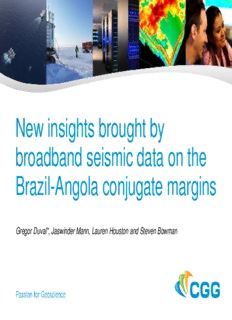
New insights brought by broadband seismic data on the Brazil-Angola conjugate margins PDF
Preview New insights brought by broadband seismic data on the Brazil-Angola conjugate margins
New insights brought by broadband seismic data on the Brazil-Angola conjugate margins Gregor Duval*, Jaswinder Mann, Lauren Houston and Steven Bowman Content Introductory remarks: why does the seismic interpreter need broadband data? Seismic surveys location (South Atlantic margin equivalence) and acquisition parameters Pre-salt exploration and broadband seismic imaging Post-salt broadband seismic benefits: facies mapping and reservoir characterisation Why does the seismic interpreter need broadband data? Effects and benefits of increasing the bandwidth 10-20Hz 10-25Hz 10-30Hz 10-35Hz Large side-lobes and Sharper broad central peak central peak Increasing high frequencies Increase low frequencies 10-20Hz 5-20Hz 2-20Hz Reduced side-lobes Effects and benefits of increasing the bandwidth BroadSeis Conventional 1000 m 20 m Conventional BroadSeis Courtesy of Total, Cobalt and the Republic of Gabon Effects and benefits of increasing the bandwidth Courtesy of Total, Cobalt and the Republic of Gabon Broadband 3D seismic surveys location and parameters Brazil Santos Basin – Broadband 3D survey Brazil Santos Basin – Broadband 3D survey Total area covered = 13,760km2 Streamer spread = 8000m x 10, 8100m x 12 BroadSeis streamer profile = 10m to 50m Streamer separation = 100m Shot-point interval = 25m Record length = 10sec PreSDM algorithm = Kirchhoff, AP-CBM and RTM Max depth output 10km Angola Kwanza Basin - Broadband 3D surveys
Description: